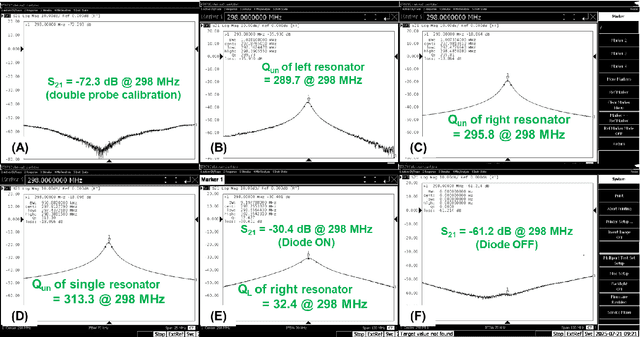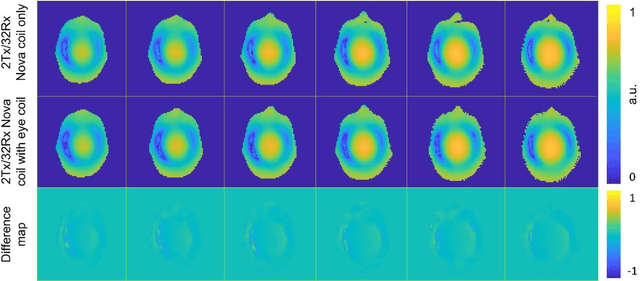Xinqiang Yan
Low-Cost and Detunable Wireless Resonator Glasses for Enhanced Eye MRI with Concurrent High-Quality Whole Brain MRI
Sep 10, 2025



Abstract:Purpose: To develop and evaluate a wearable wireless resonator glasses design that enhances eye MRI signal-to-noise ratio (SNR) without compromising whole-brain image quality at 7 T. Methods: The device integrates two detunable LC loop resonators into a lightweight, 3D-printed frame positioned near the eyes. The resonators passively couple to a standard 2Tx/32Rx head coil without hardware modifications. Bench tests assessed tuning, isolation, and detuning performance. B1$^+$ maps were measured in a head/shoulder phantom, and SNR maps were obtained in both phantom and in vivo experiments. Results: Bench measurements confirmed accurate tuning, strong inter-element isolation, and effective passive detuning. Phantom B1$^+$ mapping showed negligible differences between configurations with and without the resonators. Phantom and in vivo imaging demonstrated up to about a 3-fold SNR gain in the eye region, with no measurable SNR loss in the brain. Conclusion: The wireless resonator glasses provide a low-cost, easy-to-use solution that improves ocular SNR while preserving whole-brain image quality, enabling both dedicated eye MRI and simultaneous eye-brain imaging at ultrahigh field.
Sparse Measurement Medical CT Reconstruction using Multi-Fused Block Matching Denoising Priors
Feb 03, 2025Abstract:A major challenge for medical X-ray CT imaging is reducing the number of X-ray projections to lower radiation dosage and reduce scan times without compromising image quality. However these under-determined inverse imaging problems rely on the formulation of an expressive prior model to constrain the solution space while remaining computationally tractable. Traditional analytical reconstruction methods like Filtered Back Projection (FBP) often fail with sparse measurements, producing artifacts due to their reliance on the Shannon-Nyquist Sampling Theorem. Consensus Equilibrium, which is a generalization of Plug and Play, is a recent advancement in Model-Based Iterative Reconstruction (MBIR), has facilitated the use of multiple denoisers are prior models in an optimization free framework to capture complex, non-linear prior information. However, 3D prior modelling in a Plug and Play approach for volumetric image reconstruction requires long processing time due to high computing requirement. Instead of directly using a 3D prior, this work proposes a BM3D Multi Slice Fusion (BM3D-MSF) prior that uses multiple 2D image denoisers fused to act as a fully 3D prior model in Plug and Play reconstruction approach. Our approach does not require training and are thus able to circumvent ethical issues related with patient training data and are readily deployable in varying noise and measurement sparsity levels. In addition, reconstruction with the BM3D-MSF prior achieves similar reconstruction image quality as fully 3D image priors, but with significantly reduced computational complexity. We test our method on clinical CT data and demonstrate that our approach improves reconstructed image quality.
Fast-RF-Shimming: Accelerate RF Shimming in 7T MRI using Deep Learning
Jan 21, 2025Abstract:Ultrahigh field (UHF) Magnetic Resonance Imaging (MRI) provides a high signal-to-noise ratio (SNR), enabling exceptional spatial resolution for clinical diagnostics and research. However, higher fields introduce challenges such as transmit radiofrequency (RF) field inhomogeneities, which result in uneven flip angles and image intensity artifacts. These artifacts degrade image quality and limit clinical adoption. Traditional RF shimming methods, including Magnitude Least Squares (MLS) optimization, mitigate RF field inhomogeneity but are time-intensive and often require the presence of the patient. Recent machine learning methods, such as RF Shim Prediction by Iteratively Projected Ridge Regression and other deep learning architectures, offer alternative approaches but face challenges such as extensive training requirements, limited complexity, and practical data constraints. This paper introduces a holistic learning-based framework called Fast RF Shimming, which achieves a 5000-fold speedup compared to MLS methods. First, random-initialized Adaptive Moment Estimation (Adam) derives reference shimming weights from multichannel RF fields. Next, a Residual Network (ResNet) maps RF fields to shimming outputs while incorporating a confidence parameter into the loss function. Finally, a Non-uniformity Field Detector (NFD) identifies extreme non-uniform outcomes. Comparative evaluations demonstrate significant improvements in both speed and predictive accuracy. The proposed pipeline also supports potential extensions, such as the integration of anatomical priors or multi-echo data, to enhance the robustness of RF field correction. This approach offers a faster and more efficient solution to RF shimming challenges in UHF MRI.
Optimizing Transmit Field Inhomogeneity of Parallel RF Transmit Design in 7T MRI using Deep Learning
Aug 21, 2024Abstract:Ultrahigh field (UHF) Magnetic Resonance Imaging (MRI) provides a higher signal-to-noise ratio and, thereby, higher spatial resolution. However, UHF MRI introduces challenges such as transmit radiofrequency (RF) field (B1+) inhomogeneities, leading to uneven flip angles and image intensity anomalies. These issues can significantly degrade imaging quality and its medical applications. This study addresses B1+ field homogeneity through a novel deep learning-based strategy. Traditional methods like Magnitude Least Squares (MLS) optimization have been effective but are time-consuming and dependent on the patient's presence. Recent machine learning approaches, such as RF Shim Prediction by Iteratively Projected Ridge Regression and deep learning frameworks, have shown promise but face limitations like extensive training times and oversimplified architectures. We propose a two-step deep learning strategy. First, we obtain the desired reference RF shimming weights from multi-channel B1+ fields using random-initialized Adaptive Moment Estimation. Then, we employ Residual Networks (ResNets) to train a model that maps B1+ fields to target RF shimming outputs. Our approach does not rely on pre-calculated reference optimizations for the testing process and efficiently learns residual functions. Comparative studies with traditional MLS optimization demonstrate our method's advantages in terms of speed and accuracy. The proposed strategy achieves a faster and more efficient RF shimming design, significantly improving imaging quality at UHF. This advancement holds potential for broader applications in medical imaging and diagnostics.
 Add to Chrome
Add to Chrome Add to Firefox
Add to Firefox Add to Edge
Add to Edge